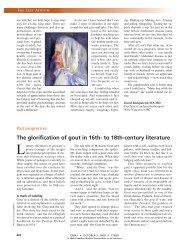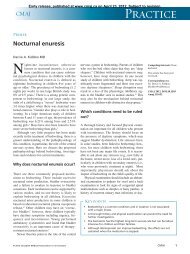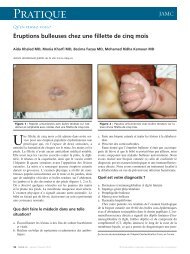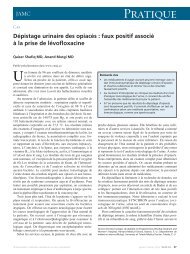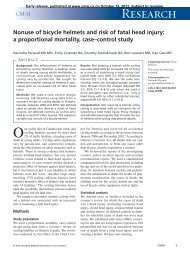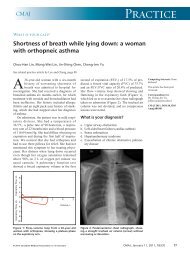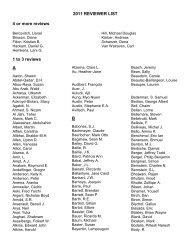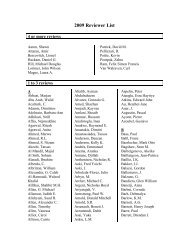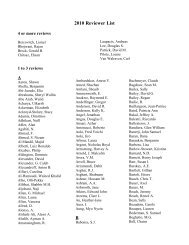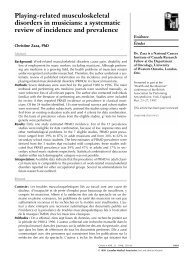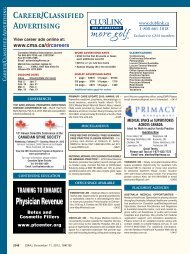Tips for teachers of evidence-based medicine: 1. Relative risk ...
Tips for teachers of evidence-based medicine: 1. Relative risk ...
Tips for teachers of evidence-based medicine: 1. Relative risk ...
You also want an ePaper? Increase the reach of your titles
YUMPU automatically turns print PDFs into web optimized ePapers that Google loves.
Barratt et al<br />
be. Point out that the NNT (as well as the <strong>risk</strong> difference)<br />
may vary significantly with the mortality <strong>risk</strong> <strong>of</strong> the individual<br />
patient, as has been demonstrated in the earlier tips<br />
in this article.<br />
The bottom line<br />
• NNT is a concise, clinically useful presentation <strong>of</strong> the<br />
effect <strong>of</strong> an intervention.<br />
• NNT is easily calculated from the <strong>risk</strong> difference.<br />
• Check whether the <strong>risk</strong> difference is presented as a percentage<br />
or a proportion and use a numerator <strong>of</strong> 100<br />
or 1 accordingly.<br />
• Care should be taken not to overestimate the effect <strong>of</strong><br />
treatments (i.e., use a value <strong>of</strong> <strong>risk</strong> difference that is too<br />
high) and thereby underestimate the NNT. 17<br />
See Appendix 2 <strong>for</strong> the summary card <strong>for</strong> this tip.<br />
Report on field-testing<br />
One <strong>of</strong> the authors (S.K.), an experienced teacher <strong>of</strong> <strong>evidence</strong>-<strong>based</strong><br />
<strong>medicine</strong> who was not involved in developing<br />
the scripts, field-tested the scripts in February 2000 with 16<br />
US medical residents during a <strong>1.</strong>5-hour teaching session.<br />
Of the 16 residents, 3 were naive learners with very little<br />
experience in <strong>evidence</strong>-<strong>based</strong> <strong>medicine</strong>, 10 had a working<br />
knowledge <strong>of</strong> <strong>evidence</strong>-<strong>based</strong> <strong>medicine</strong>, and 3 were already<br />
familiar and com<strong>for</strong>table with <strong>evidence</strong>-<strong>based</strong> <strong>medicine</strong><br />
concepts and skills.<br />
<strong>Tips</strong> 1 and 2 worked well to help learners understand<br />
relative <strong>risk</strong> reduction and <strong>risk</strong> difference, and the impact <strong>of</strong><br />
different baseline <strong>risk</strong>s on <strong>risk</strong> difference. Initially, the<br />
event and control rates in tip 1 were chosen to give a relative<br />
<strong>risk</strong> <strong>of</strong> 0.5. This had the advantage <strong>of</strong> very simple calculations<br />
but the disadvantage that the relative <strong>risk</strong> and the<br />
relative <strong>risk</strong> reduction had the same numeric value, which<br />
led to confusion. We there<strong>for</strong>e changed the event rates to<br />
avoid this problem.<br />
Tip 3 was the most popular with learners and sparked<br />
lively discussion. In the version used in the field testing,<br />
relative <strong>risk</strong> reduction was included in the tables. Learners<br />
became com<strong>for</strong>table converting between relative <strong>risk</strong><br />
reduction, <strong>risk</strong> difference and NNT. The ability to do<br />
these conversions was rated as the most important skill<br />
learners acquired by working through these exercises.<br />
S.K. found it helpful to distribute abstracts from ACP<br />
Journal Club, with the event rates left in but the relative<br />
<strong>risk</strong> reduction, <strong>risk</strong> difference and NNT blanked out.<br />
This exercise gave learners a further opportunity to practice,<br />
using real data.<br />
When asked about the relevance <strong>of</strong> the content and the<br />
clarity <strong>of</strong> the presentations, the learners gave high scores to<br />
all scripts (between 8.5 and 9.5 out <strong>of</strong> 10, on average),<br />
which indicates that they found the material both highly<br />
relevant and clear. As noted above, learners thought the<br />
most important message was the difference between relative<br />
<strong>risk</strong> reduction and <strong>risk</strong> difference and felt that it was<br />
important to be able to calculate both.<br />
Conclusions<br />
The ability to understand and calculate relative <strong>risk</strong> reduction,<br />
<strong>risk</strong> difference and NNT from data presented in<br />
clinical trials and systematic reviews is an essential skill <strong>for</strong><br />
clinicians seeking to apply clinical <strong>evidence</strong> to the care <strong>of</strong><br />
individual patients. We have presented a series <strong>of</strong> tips previously<br />
developed and used by experienced <strong>teachers</strong> <strong>of</strong> <strong>evidence</strong>-<strong>based</strong><br />
<strong>medicine</strong> <strong>for</strong> the purpose <strong>of</strong> overcoming<br />
common pitfalls that learners experience in acquiring<br />
these skills. The results <strong>of</strong> field-testing <strong>of</strong> these tips by an<br />
independent teacher, who was skilled in teaching <strong>evidence</strong>-<strong>based</strong><br />
<strong>medicine</strong> to clinical learners but was previously<br />
unfamiliar with these approaches, suggests that<br />
other educators may find this material useful in their own<br />
teaching.<br />
This article has been peer reviewed.<br />
From the School <strong>of</strong> Public Health, University <strong>of</strong> Sydney, Sydney, Australia (Barratt);<br />
the Columbia University College <strong>of</strong> Physicians and Surgeons, New York, NY<br />
(Wyer); the Department <strong>of</strong> Medicine, University <strong>of</strong> British Columbia, Vancouver,<br />
BC (Hatala); Mount Sinai Medical Center, New York, NY (McGinn); the Department<br />
<strong>of</strong> Internal Medicine, University <strong>of</strong> the Philippines College <strong>of</strong> Medicine,<br />
Manila, The Philippines (Dans); Durham Veterans Affairs Medical Center and<br />
Duke University Medical Center, Durham, NC (Keitz); the Department <strong>of</strong> Pediatrics,<br />
University <strong>of</strong> Texas, Houston, Tex. (Moyer); and the Departments <strong>of</strong> Medicine<br />
and <strong>of</strong> Clinical Epidemiology and Biostatistics, McMaster University, Hamilton,<br />
Ont. (Guyatt)<br />
Competing interests: None declared.<br />
Contributors: Alexandra Barratt contributed tip 2, drafted the manuscript, coordinated<br />
input from coauthors and reviewers and from field-testing, and revised all<br />
drafts. Peter Wyer edited drafts and provided guidance in developing the final <strong>for</strong>mat.<br />
Rose Hatala contributed tip 1, coordinated the internal review process and<br />
provided comments throughout development <strong>of</strong> the manuscript. Thomas McGinn<br />
contributed tip 3 and provided comments throughout development <strong>of</strong> the manuscript.<br />
Antonio Dans reviewed all drafts and provided comments throughout development<br />
<strong>of</strong> the manuscript. Sheri Keitz conducted field-testing <strong>of</strong> the tips and contributed<br />
material from the field-testing to the manuscript. Virginia Moyer<br />
reviewed and contributed to the final version <strong>of</strong> the manuscript. Gordon Guyatt<br />
helped to write the manuscript (as an editor and coauthor).<br />
References<br />
<strong>1.</strong> Malenka DJ, Baron JA, Johansen S, Wahrenberger JW, Ross JM. The framing<br />
effect <strong>of</strong> relative and absolute <strong>risk</strong>. J Gen Intern Med 1993;8:543-8.<br />
2. Forrow L, Taylor WC, Arnold RM. Absolutely relative: How research results<br />
are summarized can affect treatment decisions. Am J Med 1992;92:121-4.<br />
3. Naylor CD, Chen E, Strauss B. Measured enthusiasm: Does the method <strong>of</strong><br />
reporting trial results alter perceptions <strong>of</strong> therapeutic effectiveness? Ann Intern<br />
Med 1992;117:916-2<strong>1.</strong><br />
4. Fahey T, Griffiths S, Peters TJ. Evidence <strong>based</strong> purchasing: understanding<br />
results <strong>of</strong> clinical trials and systematic reviews. BMJ 1995;311:1056-60.<br />
5. Wyer PC, Keitz S, Hatala R, Hayward R, Barratt A, Montori V, et al. <strong>Tips</strong><br />
<strong>for</strong> learning and teaching <strong>evidence</strong>-<strong>based</strong> <strong>medicine</strong>: introduction to the series<br />
[editorial]. CMAJ 2004;171(4):347-8.<br />
6. Guyatt G, Rennie D, editors. Users’ guides to the medical literature: a manual <strong>for</strong><br />
<strong>evidence</strong>-<strong>based</strong> clinical practice. Chicago: AMA Publications; 2002.<br />
7. Barratt A, Wyer PC, Hatala R, McGinn T, Dans AL, Keitz S, et al. <strong>Tips</strong> <strong>for</strong><br />
learners <strong>of</strong> <strong>evidence</strong>-<strong>based</strong> <strong>medicine</strong>: <strong>1.</strong> <strong>Relative</strong> <strong>risk</strong> reduction, absolute <strong>risk</strong><br />
reduction and number needed to treat. CMAJ 2004;171(4):353-8.<br />
8. Schmid CH, Lau J, McIntosh MW, Cappelleri JC. An empirical study <strong>of</strong> the<br />
effect <strong>of</strong> the control rate as a predictor <strong>of</strong> treatment efficacy in meta-analysis<br />
<strong>of</strong> clinical trials. Stat Med 1998;17:1923-42.<br />
Online-6 JAMC • 17 AOÛT 2004; 171 (4)



